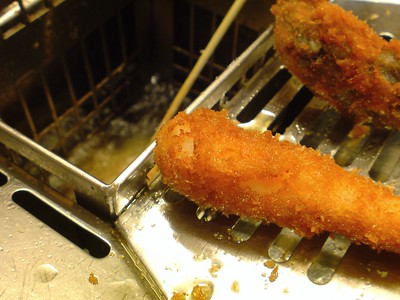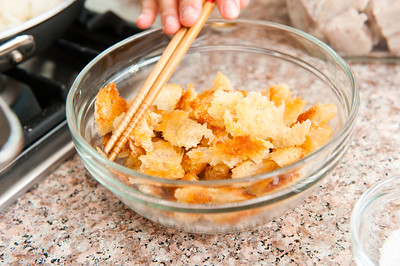Like many people, you might think having a deep fryer in your home would be a wonderful addition to your kitchen appliances collection. And you would be right. Deep-fat fryers are versatile cooking instruments that allow home cooks to prepare a variety of savoury and delectable meals and snacks.
They are relatively maintenance-free, too. You might only need to perform routine maintenance on your deep fryer every few weeks to every couple of months, depending on how frequently you deep fry foods. In addition, most components on deep fryers are removable and dishwasher-safe, which makes them very easy to keep clean.
You can also cook a wide range of foods in a deep fryer, from fish and chips and fried chicken to desserts such as doughnuts and funnel cakes. Whatever you choose to fry, getting started with your deep fryer is quick and simple. We’re here to show you how to use a deep-fat fryer so you can make the most of your appliance.
Quick Start Guide

- Add frying oil to your fryer. Ensure it reaches the maximum fill line as indicated on the cooker’s interior. Don’t add too much oil or you risk starting a fire.
- Turn the fryer on and adjust the temperature. Allow the oil ample time to reach its optimal temperature.
- Add food to the oil. Use the included food basket or a slotted spoon to prevent splashing hot oil. Don’t let your food sit in cold oil.
- Set a timer and adjust the thermostat to the right temperature. Give your food plenty of cook time. Always ensure your food reaches the proper internal temperature for safe eating.
- Remove your food from the oil and let it drain away excess oil. Lift the basket, hook it on the side, or use a slotted spoon to take the food out of the oil and onto paper towels or a drying rack.
- After your food has cooled enough to eat, enjoy your fried meal.
What Oil is Best for Deep Frying?
A wide range of oils can be used in deep fryers, but vegetable and canola oil are the most common. These two oils are extremely versatile. They have a high smoke point and can be used for many foods.
Oils such as peanuts and olive oil are known to transfer flavour onto your foods, so they are usually avoided for more delicate fried foods such as doughnuts. Alternatively, peanut oils of different clarities are commonly used for fried chicken and turkey, as the added peanut flavour is said to make a nice addition to the meat.
Oils you may consider using in your deep-fat fryer are:
- Peanut: 227 degrees Celsius maximum temperature
- Sunflower: 232 degrees Celsius maximum temperature
- Coconut Oil: 232 degrees Celsius maximum temperature
- Olive: 190 degrees Celsius maximum temperature
- Corn: 232 degrees Celsius maximum temperature
- Rapeseed: 204 degrees Celsius maximum temperature
- Vegetable Oil: 232 degrees Celsius maximum temperature
- Canola: 204 degrees Celsius maximum temperature
Different Oil Smoke Points
Each oil has its own smoke points, as seen in the list above. Smoke points are the temperature at which an oil can be safely used. The higher the degrees, the safer it is for use in a deep fryer.

Most deep fryers have an easily adjustable temperature, while others are set to a specific range and can reach high temperatures to create deep-fried food within minutes. Check your owner’s manual to know the maximum temperature your fryer can reach.
Olive oil, for example, is an extremely popular oil for pan-frying and sauteeing but has a very low smoke point compared to the other oils on the list. It can be used in deep fryers with temperature adjustment options but needs to be watched closely to ensure it does not start smoking or catch fire.
Regular Oil Filtering
Regularly filtering your used oil is a great way to help extend its usable life. As you cook foods in your fryer, food particles will collect at the bottom of the oil tray.
Clean fryer oil also heats up much better than oil with some food particles. As a result, this cuts down on time needed to let your fryer heat up before adding your food.
What Foods Can Be Deep Fried?
There are quite a few limitations regarding what foods can be fried. Every year, some new recipe comes around on social media with different foods no one had thought of frying before.
A wide range of state fairs in the United States has come up with unusual recipes for fried foods. These get unique each year. There are entire annual contests for fried dishes and different ways people can fry common foods.
Some of the more common fried foods include:
- Chicken Wings, Nuggets, Strips and Fillets
- Potato or Meat Fritters
- Potato or Vegetable Crisps and Chips
- Doughnut Rings and Doughnut Balls
Some unique or bizarre fried foods include:
- Sticks of Butter on a Batter
- Ice Cream Scoops and Ice Cream Bars
- Apple Pie and Cheesecake
- Green Tomatoes and Red Tomatoes
- Pickles and Cucumber Slices
- Candy Bars, Cookie Dough and Chocolate Drops
Proper Food Temperatures

Food poisoning can occur if raw meats are not cooked to the right internal temperature. With a properly working deep fryer, this is rarely an issue. However, it is a good practice to keep a meat thermometer nearby to check internal temperatures, especially if you will be frying many slices of raw meat, such as chicken or beef.
Safe internal temperatures include:
- Chicken – 74 degrees Celsius
- Turkey – 74 degrees Celsius
- Gamebird – 74 degrees Celsius
- Beef – 63 degrees Celsius
- Pork – 63 degrees Celsius
- Fish – 63 degrees Celsius
- Shellfish – 63 degrees Celsius
Deep Fryer Safety Tips
1. Avoid tossing frozen food into hot oil.
This can lead to excessive oil splattering, which may cause burns to your hands, arm or face. Allow frozen foods a short time to thaw gently, or use a paper towel to remove as many exterior ice crystals as possible before placing the food item into the hot oil.
2. Keep deep fryer cords up and away from children and pets.
Most fryers have short cords that retract into the back of the unit, eliminating the chance that a child or pet can pull them. But other units, such as bucket-style fryers, may have long cords that hang over the edge of a countertop. Always be sure cords are kept away from curious children and pets to prevent hot oil accidents.
3. Let the oil cool down before filtering or draining the fryer.
Periodic replacement of oil and cleaning of the fryer is a good habit, but be certain that the oil has thoroughly cooled before handling it. This can take a few hours, so don’t be afraid to leave the task until later in the day when everything has cooled down.
4. Keep a fire extinguisher near your deep fry unit.
There is always the risk of an oil fire, whether using a pan or a deep-fry unit. It’s always better to have the fire extinguisher and not need it than to need it and not have it. A fire blanket is a suitable alternative to extinguish burning oil.
Get Ready to Fry
From your first deep fryer to the one you have had for years, there is probably a food recipe you have yet to try. Deep-frying foods can be fun for you and your family. Add a new twist to an old favourite by changing the spices or batter, or go out on a limb and try something completely new! Regardless of your choice, there is no shortage of great foods for deep frying.

